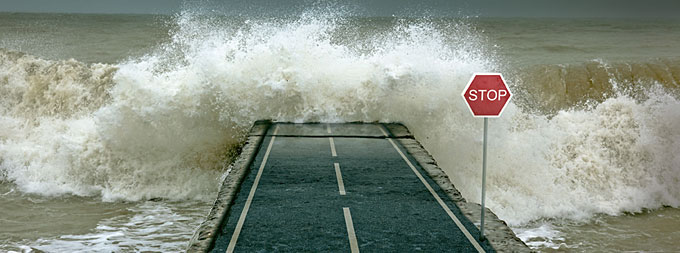The Federal Emergency Management Agency (FEMA) has placed more than 20,000 communities in the United States into a category of flood zones. Each community is able to participate in the agency’s National Flood Insurance Program (NFIP), with premium rates determined by the risks of flooding. To indicate the risks in different parts of the country, FEMA has assigned a character from the alphabet to each zone.
The most hazardous flood zones are V (usually first-row, beach-front properties) and A (usually, but not always, properties near water).
V Zones
According to FEMA and the National Flood Insurance Program, any building located in an A or V zone is considered to be in a Special Flood Hazard Area, and is lower than the Base Flood Elevation. V zones are the most hazardous of the Special Flood Hazard Areas. V zones generally include the first row of beachfront properties. The hazards in these areas are increased because of wave velocity – hence the V designation. Flood insurance is mandatory in V zone areas.
Living in a V Zone
If your home is in a “V” zone (this includes VE and V-1-V-30), adhere to the following recommendations:
- • The bottom of the lowest horizontal structural member of the lowest floor elevation must be at or above the Base Flood Elevation (BFE).
- • Enclosed areas below the lowest floor cannot be used for living space. The building must be elevated on piles, piers, posts or column foundation.
- • Electrical, heating ventilation, plumbing, air conditioning equipment and other service facilities must be elevated to or above the BFE.
A Zones
A zones – the next most volatile of the Special Flood Hazard Areas – are subject to rising waters and are usually near a lake, river, stream or other body of water. Flood insurance is mandatory in all A zones because of the high potential of flooding. A-zone maps also include AE, AH, AO, AR and A99 designations, all having the same rates. The different A zones are named depending on the way in which they might be flooded.
Living in an A Zone
If your home is in an A zone (includes AE, A1-A30, AH, AO, AR) follow these important recommendations:
- • The lowest floor elevation must be at or above the Base Flood Elevation (BFE).
- • Enclosed areas below the lowest floor cannot be used for living space.
- • Electrical, heating, ventilation, plumbing, air conditioning equipment and other service facilities must be elevated to or above the BFE.
Other Zones
- • X zones are minimal-risk areas where flood insurance is not mandatory.
- • D zones are areas that have not been studied, but where flooding is possible.
Finding Your Zone Information
There are several ways to find out which zone applies to you. You can determine your risk online by visiting floodsmart.gov. You can also go to your town hall or city hall, where employees responsible for issuing building permits in your area have access to flood zone maps. If you are buying a home, your Realtor and your insurance agent should be able to help you. Also, you can view your flood map by visiting the FEMA Map Service Center website at http://msc.fema.gov or by calling (800) 358-9616.

